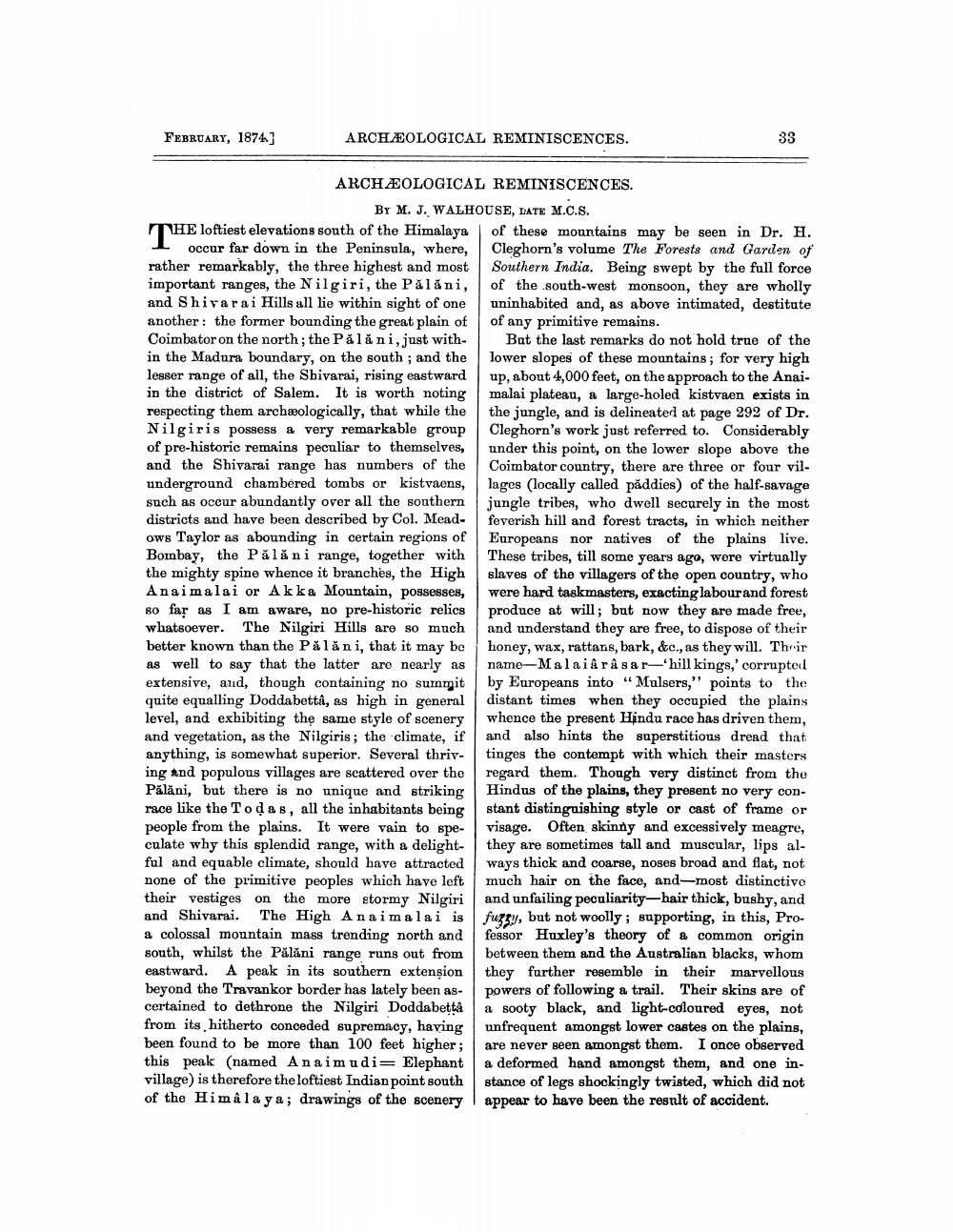________________
FEBRUARY, 1874)
ARCHÆOLOGICAL REMINISCENCES.
ARCHÆOLOGICAL REMINISCENCES.
BY M. J. WALHOUSE, LATE M.C.S. THE loftiest elevations south of the Himalaya of these mountains may be seen in Dr. H.
1 occur far down in the Peninsula, where, Cleghorn's volume The Forests and Garden of rather remarkably, the three highest and most Southern India. Being swept by the full force important ranges, the Nilgiri, the Pålåni, of the south-west monsoon, they are wholly and Shivarai Hills all lie within sight of one uninhabited and, as above intimated, destitute another: the former bounding the great plain of of any primitive remains. Coimbator on the north; the Pălăni, just with- But the last remarks do not hold true of the in the Madura boundary, on the south; and the lower slopes of these mountains; for very high lesser range of all, the Shivarai, rising eastward up, about 4,000 feet, on the approach to the Anaiin the district of Salem. It is worth noting malai plateau, a large-holed kistvaen exists in respecting them archæologically, that while the the jungle, and is delineated at page 292 of Dr. Nilgiris possess a very remarkable group Cleghorn's work just referred to. Considerably of pre-historic remains peculiar to themselves, under this point, on the lower slope above the and the Shivarai range has numbers of the Coimbator country, there are three or four vilunderground chambered tombs or kistvaens, lages (locally called påddies) of the half-savage such as occur abundantly over all the southern jungle tribes, who dwell securely in the most districts and have been described by Col. Mead- feverish hill and forest tracts, in which neither ows Taylor as abounding in certain regions of Europeans nor natives of the plains live. Bombay, the Pălăni range, together with These tribes, till some years ago, were virtually the mighty spine whence it branches, the High slaves of the villagers of the open country, who Anaimalai or Akka Mountain, possesses, were hard taskmasters, exacting labourand forest 80 far as I am aware, no pre-historic relics produce at will; but now they are made free, whatsoever. The Nilgiri Hills are so much and understand they are free, to dispose of their better known than the Pălăni, that it may be honey, wax, rattans, bark, &c., as they will. Thrir as well to say that the latter are nearly as name-Malai & råsar-'hill kings,' corrupted extensive, and, though containing no summit by Europeans into "Mulsers," points to the quite equalling Doddabettå, as high in general distant times when they occupied the plains level, and exhibiting the same style of scenery whence the present Hindu race has driven them, and vegetation, as the Nilgiris; the climate, if and also hints the superstitious dread that anything, is somewhat superior. Several thriv- tinges the contempt with which their masters ing and populous villages are scattered over the regard them. Though very distinct from the Pălăni, but there is no unique and striking Hindus of the plains, they present no very conrace like the Todas, all the inhabitants being stant distinguishing style or cast of frame or people from the plains. It were vain to spe- visage. Often skinny and excessively meagre, culate why this splendid range, with a delight- they are sometimes tall and muscular, lips alful and equable climate, should have attracted ways thick and coarse, noses broad and flat, not none of the primitive peoples which have left much hair on the face, and-most distinctivo their vestiges on the more stormy Nilgiri and unfailing peculiarity-hair thick, bushy, and and Shivarai. The High Ana imalai is fuggy, but not woolly ; supporting, in this, Proa colossal mountain mass trending north and fessor Huxley's theory of a common origin south, whilst the Pălăni range runs out from between them and the Australian blacks, whom eastward. A peak in its southern extension they further resemble in their marvellous beyond the Travankor border has lately been as- powers of following a trail. Their skins are of certained to dethrone the Nilgiri Doddabetta a sooty black, and light-coloured eyes, not from its hitherto conceded supremacy, having unfrequent amongst lower castes on the plains, been found to be more than 100 feet higher; are never seen amongst them. I once observed this peak (named Anaimudi= Elephant a deformed hand amongst them, and one invillage) is therefore the loftiest Indian point south stance of legs shockingly twisted, which did not of the Himalaya; drawings of the scenery appear to have been the result of accident.




